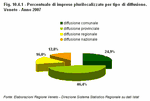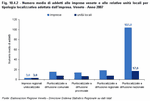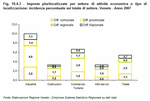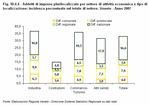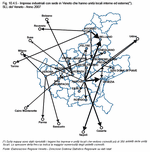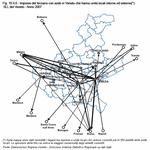One aspect of entrepreneurial networking refers to the control of production units within a territory: unlike the factor of labour, by endogenous definition, production units can represent firms in the same area, or they can be controlled by an enterprise that has its headquarters elsewhere. This analysis allows us to study the networks drawn within an area by relationships between firms and production areas and can help us understand whether it is areas with more lively endogenous entrepreneurship that are more competitive or areas with local units established by external businesses.
In 2007 in Veneto, there were 21,667 multi-location businesses and which accounted for 5.3% of its total number of active businesses. These businesses were organised into 58,595 local units, of which 49,306 in Veneto. On average, they had 2.7 local units per business. The multi-location businesses measured in terms of labour had 571,582 employees, of which 459,763 were in the same region.
(Table 10.4.1) and
(Figure 10.4.1)
In 46.4% of cases, the multi-location businesses in Veneto were localised by province, 25.3% by municipality, 16% by region, and, finally, by 12.8% have local units throughout Italy. It should be underlined that the businesses localised nationally, even though they were few in number, employ nearly half of multi-location employees and control on average a higher number of local units: 6 for each business.
(Figure 10.4.2).
As is obvious, the size of the business was linked to the complexity of the localisation adopted: compared to an average number of employees of 4.3 in 2007, single-location businesses had 3, while multi-location businesses had 26. Among the latter a smaller average size was found in those localised by municipality, by province and by region, while firms in Veneto that were also delocalised in other regions had 104 employees on average. The average number of employees is even larger for non-Veneto firms with local units in Veneto, that is 336 employees.
The size of firm strongly influenced the tendency to multi-locate, as the number of employees increased so did multi-localation: 3.8% of firms with fewer than 10 employees were multi-location, 25.1% of small firms (10-49 employees), 50.2% of medium-size firms (50-249 employees), and 83.2% of large firms (more than 250 employees).
(Table 10.4.2).
The propensity to multi-locate is influenced also by the sector of economic activity: a higher-than-average percentage of multi-location businesses and the relative number of employees was found in industry, trade and tourist services. In industry, 10% of the firms were multi-location and they employed 36.6% of the workers in the sector; in trade and tourism 6.7% of businesses were multi-location and employed 36% of the workers in the sector. Overall for other services, the share was rather consistent in terms of employees, 31.6%, but only 3.3% of the firms were multi-location. Construction had a below-average rate of multi-location in terms of both firms, 3.3%, and employees, 14.8%.
In all sectors, multi-location occurs mainly at provincial level if firms are analysed, while if the analysis is of employees, multi-location is mainly national.
(Figure 10.4.3) and
(Figure 10.4.4)
In a context where urban and metropolitan development has contributed to the growth of geographical relationships in Veneto's business world, it is interesting to study the configuration of production links within the territory, with the purpose of revealing the existence of networks within the production system, which are unquestionably related to the varied socio-economic traits of the areas involved.
For this purpose, Veneto's multi-location firms were analysed by using the network analysis technique, which is able to describe interaction between the parent companies and their respective subordinate units. The analysis was carried out on the local labour systems (SLLs), i.e. geographical units defined by a group of neighbouring municipalities linked by daily flows of commuters for employment found in the last census. The local labour systems are defined by clustering municipalities, regardless of their administrative boundaries, through the criteria of self-centring, that is the ability of the system to offer production and service activities so as to create employment and residential opportunities for the majority of the population, as well as proximity and distance travelled and time spent travelling between the places of residence and employment. The local labour systems represent the place where the people who reside and work there live their daily lives; these units are suitable for investigating the socio-economic structure of the territory, examining relationships more thoroughly than would be possible by provincial analysis and, at the same time, mitigating the difficulties of managing and representing a study on a municipal level.
The study observes the local units of businesses with parent companies in Veneto, without involving the local units present in Veneto which belong to businesses headquartered in other regions; the analysis will then go on to study the centrality and the endogenous attractiveness of the local employment areas of Veneto through the study of the multi-location of firms from Veneto, without considering the exogenous attractiveness of the same units.
The analysis measures the degree of linkage between the parent company and the local unit by the number of employees in the latter, considering only local units in local labour systems outside its parent company.
The diagram reproduces the principal links throughout the local system, through directional arrows connecting the local systems of the parent company with those of its respective local units. The thickness of each arrow is proportional to the strength of the link, that is to the number of employees in the local area of "destination" who belong to parent companies in the system of "origin".
A strong manufacturing tradition in Veneto calls for the industrial sector to be looked at first, so as to verify whether Veneto corresponds to a well-consolidated, but constantly evolving, "district model". To ensure the information is easier to read, the map only includes links with local units involving more than 350 employees
(Note 1).
(Figure 10.4.5).
The configuration allows us to see the dominant connection between the local systems of Padova and Venezia, which involves numerous industrial employees of the province of Padova who work in local units in the province of Venezia, especially in the sectors of construction, but also in the eyewear, mechanical and leather industries; Padova also has significant links with the local system of Este, especially concerning the textile and metal industries, and with that of Rovigo for the electro-mechanical industries. Castelfranco Veneto is in its turn linked to the local system of Padova through employees in the mechanical, construction and leather industries. No less important are the relations between the local system of Belluno and the systems of Padova and Agordo, where eyewear is a major industry. Other internal networks of a certain importance are between Venezia, Treviso and San Doną di Piave principally in the metal, wood and construction industries, and the one between Bassano, Feltre and Padova, which is also important in the metal industry. The local system of Vicenza is the central node of a network that is substantially independent from the rest of the system: firstly, a number of the employees of the textile, leather and electrical industries of Vicenza are employed in the neighbouring local units of Thiene and San Bonifacio. These local employment areas of Veneto are part of a network that extends into other regions, in particular those of the local systems of Trento and of the North-West of Italy, in which the metal and mineral industries stand out. The local system of Verona is also the centre of a small network that involves especially employees of the food and pharmaceutical industries, employed in the local systems of Conegliano and the local systems of Lombardia and Emilia Romagna.
Moreover, the industrial sector clearly has a hub-and-spokes configuration, with various weaker links outside the primary network: Verona, San Bonifacio, Vicenza, Padova, Venezia and Agordo are local systems in Veneto which have relationships outside the region that involve more 350 employees. The presence of these links demonstrates a propensity of the industrial system of Veneto to synergetic growth, because its openness to various contexts beyond its origins provides a very significant contribution, especially in terms of know-how and innovation.
Two measures of node centrality, i.e. the centrality of the local systems depicted, can be calculated in order to better understand the importance of the system: out-degree is a measure of the strength of "active" links that a local labour system establishes, i.e. it grows with the number of employees in a local unit within other systems controlled by firms with their headquarters in the local system being examined. The in-degree, however, measures the strength of "passive" links that concern the local system, i.e. it grows with an increase in the number of employees in local units belonging to a local system controlled by a firm with its headquarters in another local system. The out-degree is higher for Padova, Verona, Vicenza, Venezia and Agordo, while the in-degree is greater for Belluno, Venezia, Padova; however, it should be kept in mind that the repeated presence of the local systems of provincial capitals may be due in part to their greater size and their favourable position along the main transport and communication routes of Veneto's economy.
The network built on the number of local units, instead of on their size, shows different relationships to those described up to this point: the strongest bond in the network, the one between the local systems of Padova and Venezia, no longer lies in the classic Padova-Venezia-Treviso triangle, but in a rectangle that also includes the local labour system of Castelfranco Veneto, related especially to the mechanical, leatherworking and furniture sectors.
The structure of the services network in Veneto has to be portrayed keeping in mind that we are analysing some sectors of the economy in which local units may have quite varied roles regarding the parent company, for example in trade or banking, and, at times, they may be even more limited and subordinate. Also in this case the threshold established for inclusion in the vector diagram of the links between the local labour systems has been set at 350 employees
(Note 2).
(Figure 10.4.6).
The strongest links are in this case between the local labour system of Venezia and the most important centres of services in Italy: Roma and Milano. The sectors that link the local systems are principally trade, catering and staffing services. These key local systems are connected, less strongly, to the local systems of Padova, Verona, Vicenza and Castelfranco Veneto. The network structure of Veneto has robust relations between the local systems linked to the central belt of the region: Padova and Venezia have very strong relationships in the sectors of trade, transport and warehousing, hotels and restaurants; many of the employees in services in Venezia, especially in trade, catering and staffing services, are also employed in the local system of Treviso.
All of these nodes maintain significant multi-location ties with local systems of other Italian regions, especially concerning employees working in trade, financial intermediation and staffing services; Verona manages a good number of employees in the local systems of Emilia Romagna; Padova administers many employees in the regions of Toscana and Friuli; while Venezia interfaces with the local systems of Friuli, Emilia Romagna, Toscana and Campania. The sector of staffing services is important because all the persons managed by employment agencies and other firms specialised in finding personnel are employees of the company itself, even though they are sought and employed by other firms.
The production links described make it clear that Veneto is producing within a network that tends to form relationships that break with the local character of the giant systems of mass production and allow for various degrees of ubiquity and territorial interaction.







